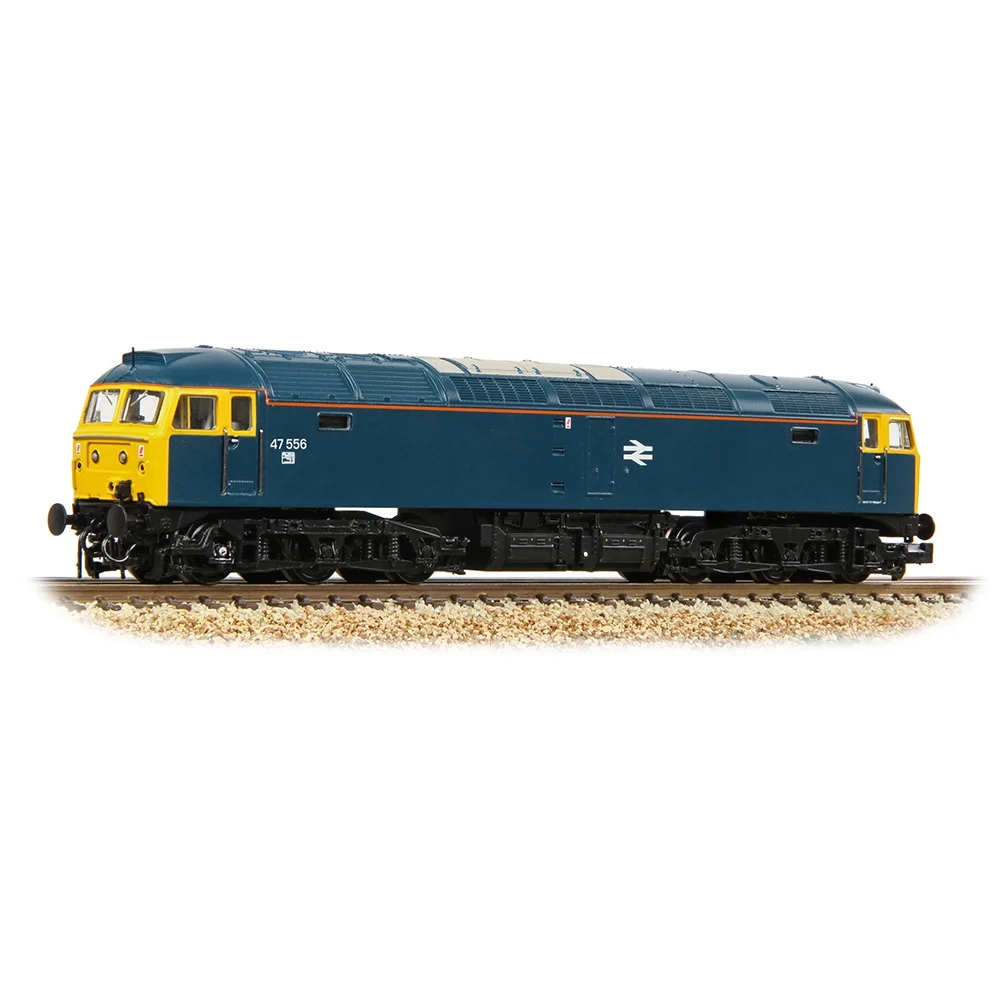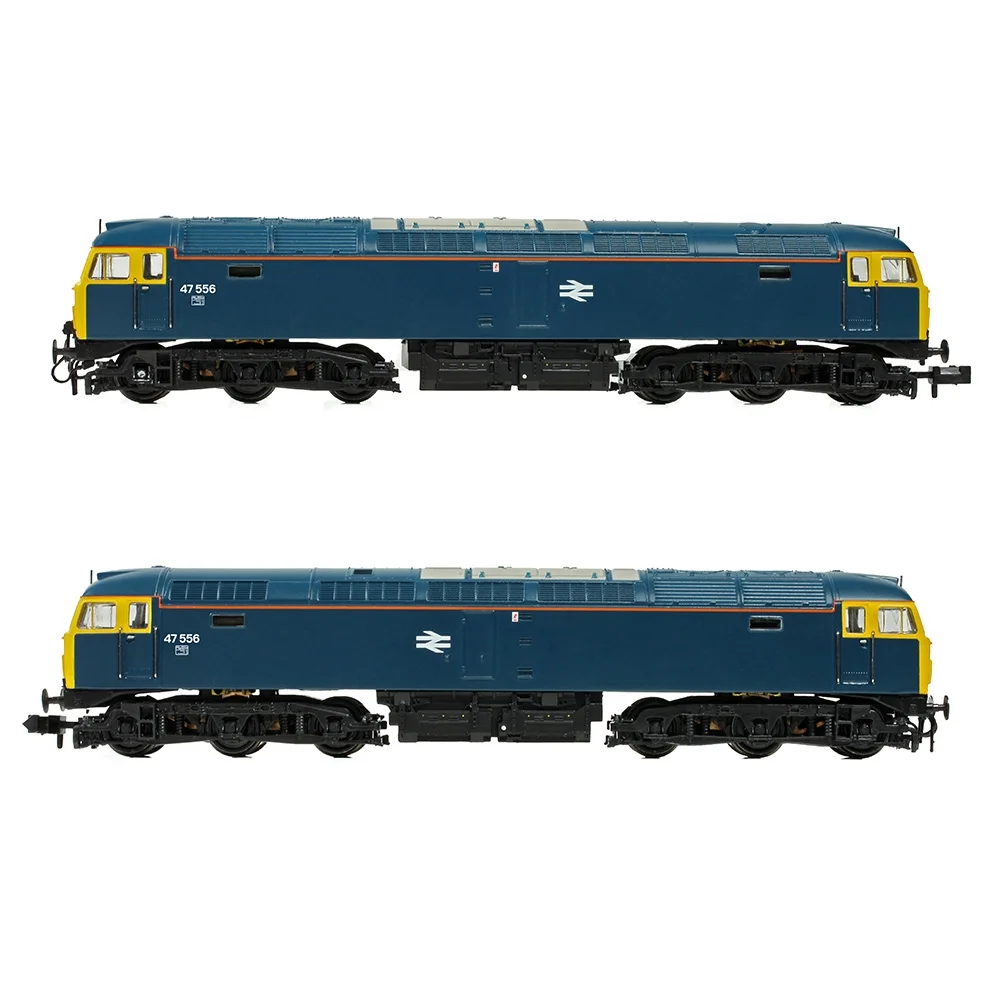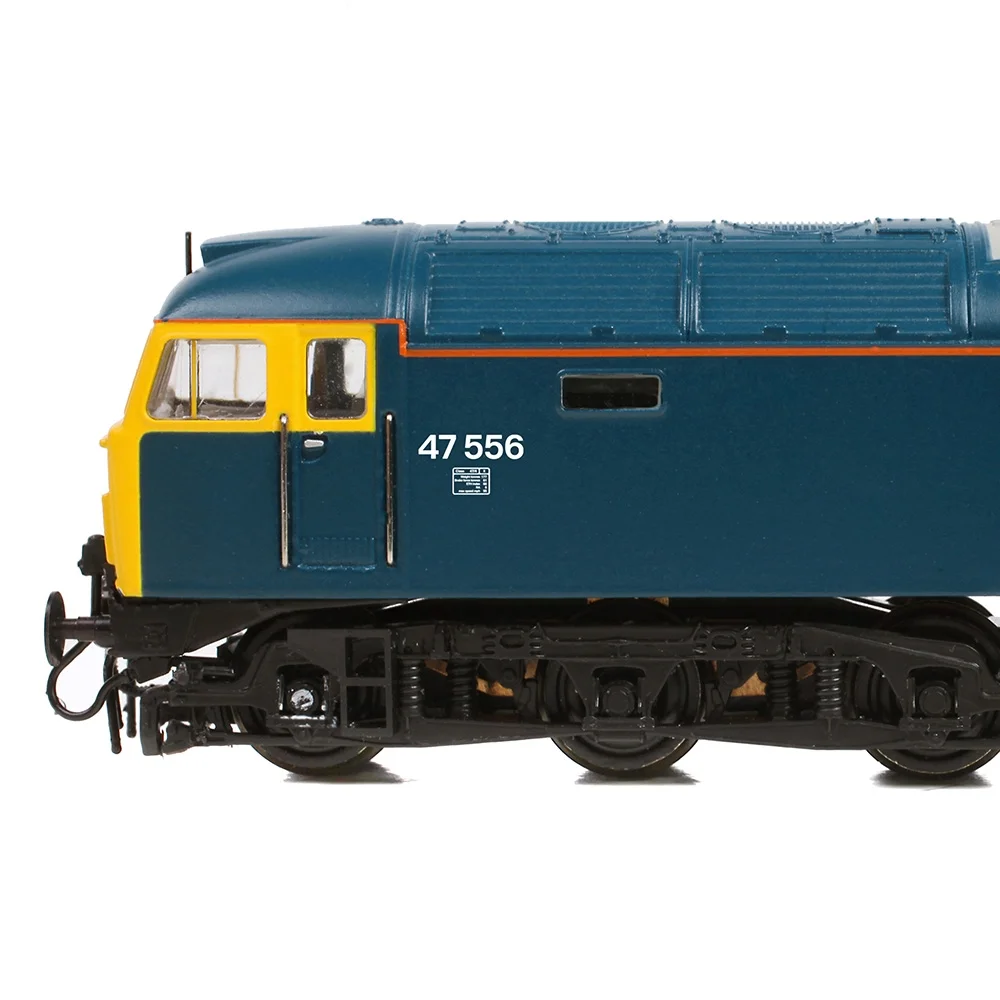Graham Farish 371-829BSF
British Rail Class 47/4 47556 British Rail Blue
Graham Farish's Description & Specifications
The Class 47 was British Railways’ most prolific class of main-line diesel locomotive and so it’s no surprise that high fidelity models of these ever-popular machines are available in N Scale as part of the flagship Graham Farish range.
Such were the variations that appeared across the fleet, whether from new or following modifications or refurbishment, that various sub-classes were used to highlight particular features and the Class 47/4s were those locomotives fitted with Electric Train Heating such as No. 47556.
This model takes full advantage to the recent upgrades that have benefited the Graham Farish Class 47, namely the technical advancements which see the model boasting a Next18 DCC decoder interface, pre-fitted speaker, cab lighting (when used on DCC) and independent control of the directional lights at each end. With the Next18 interface and pre-fitted speaker, SOUND FITTED models can now be offered for the first time.
- Graham Farish N Scale
- Era 8
- Pristine BR Blue livery
- Running No. 47556
- SOUND FITTED – Fitted with a ESU Loksound V5DCC Sound Decoder
- Length 139mm (over couplings)
DETAIL VARIATIONS SPECIFIC TO THIS MODEL
- Plated Headcode Panels with Sealed Beam Marker Lights at No. 2 End
- Cab-Front Mounted ETH Equipment
- Single Arm Windscreen Wipers
- High Intensity Headlight
- Round Buffers
- Full Cab Roof Vents
- Serck Radiator Grilles
- Smooth Exhaust Panels
- Plated Spanner Mk3 Roof Boiler Port
- 1,250 Gallon Water Tanks with Water Filler Valves
- NRN Aerials
- Plated Bogie-mounted Cab Steps
GRAHAM FARISH CLASS 47 SPECIFICATION
MECHANISM:
- Coreless, twin shaft motor with two flywheels providing drive to both bogies
- All axle drive
- Electrical pickup from eight wheels
- Diecast metal chassis block
- Gearing arranged for prototypical running speeds and haulage capabilities
- 9mm (N gauge) wheels to NEM310 standards with authentic profile and detailing
- Bogie-mounted coupling pockets to NEM355 standards at each end
- Designed to operate on curves of second radius (263.5mm) or greater
DETAILING:
- Bogies constructed from multiple components featuring full relief detail
- Separately applied detail parts, including lamp irons, cab handrails and roof aerial (where applicable)
- Separately fitted battery box/water/fuel tank assembly
- Cab Interior Detailing
- Each model supplied with a full set of model-specific bufferbeam pipework and accessory parts
LIGHTING:
- Directional lighting, switchable on/off at either end on DCC or Analogue control
- Cab lighting, switchable on/off (when used on DCC only)
- Authentic light colours and temperatures selected for each model based on era and application
DCC:
- Next18 DCC decoder interface
SOUND:
- Speaker installed in all models for optimum sound reproduction
- ESU Loksound V5DCC Sound Decoder fitted to SOUND FITTED versions
- Sound files produced specifically for the Graham Farish Class 47 using recordings from real locomotives
- SOUND FITTED models operate on DCC and Analogue control as supplied
LIVERY APPLICATION:
- Authentic liveries applied to all models
- Multiple paint applications employed on each model using BR/TOC specification colours
- Logos, numerals and text added as appropriate using multi-stage tampo printing using authentic typefaces, logos and colours
Class & Prototype
- Class: British Rail Class 47/4
- Traction: Diesel
- Transmission: Electric
- Built: 1962-1987
- Total Built: -
The British Rail Class 47, or Brush Type 4, built 1962-1968, represents Britain's most numerous mainline diesel with 512 locomotives constructed by Brush Traction and BR Crewe Works. Despite early reliability problems, a mid-1960s decision to derate engines from 2,750 to 2,580 bhp transformed the class into Britain's most dependable mixed-traffic locomotive, achieving 55+ years service. Operating across all BR regions hauling everything from royal trains to coal hoppers, Class 47s wore over 30 distinct liveries spanning BR green through colourful sector schemes to privatisation colours. Currently, Bachmann and Heljan produce exceptional OO gauge models with motorised fans, ESU LokSound V5 sound, and 150+ detail parts, while Graham Farish dominates N gauge. With 32 preserved locomotives and continuing heritage operations, the "Duff" remains an iconic part of British railway heritage.
No prototype found.
Operator & Livery
- Operator: British Rail
- Livery: Blue
British Rail (1965-1997) transformed Britain's railways through revolutionary modernisation, introducing the iconic double arrow logo, Rail Blue livery, and business sectorisation. BR pioneered high-speed rail with the InterCity 125 and Advanced Passenger Train, electrified major routes, and created profitable divisions like InterCity and Network SouthEast. From steam succession through diesel and electric development to privatisation preparation, British Rail's diverse locomotive fleet, multiple livery schemes, and operational scenarios provide unparalleled variety for railway modellers across all scales and periods.
BR Blue, also known as Rail Blue or Monastral Blue, was introduced in 1965 as part of British Rail's comprehensive corporate identity overhaul that accompanied the rebranding from British Railways to British Rail. The colour was officially defined by British Standards BR28/6001 (airless spray finish) and BR28/5321 (brush finish), representing a dark, greyish blue tone specifically chosen to hide dirt and weathering effects well.
The livery was prototyped on the experimental XP64 train in 1964 before becoming the standard scheme from 1 January 1965. Rail Blue was applied to all diesel and electric locomotives with yellow warning panels (initially small, then extending to full yellow ends from 1966). The standardised application included the iconic double arrow logo and Rail Alphabet typeface, creating one of the most successful transport corporate identities of the 20th century.
The livery dominated British Rail operations for over two decades until sectorisation in the 1980s began fragmenting the unified appearance. Despite initial colour fading problems in early applications, these were resolved by the late 1970s when the Large Logo variant was introduced featuring extended yellow areas and full-height double arrow symbols. Rail Blue's enduring appeal among railway enthusiasts reflects its role as the definitive British Rail image during the organisation's most unified period.




